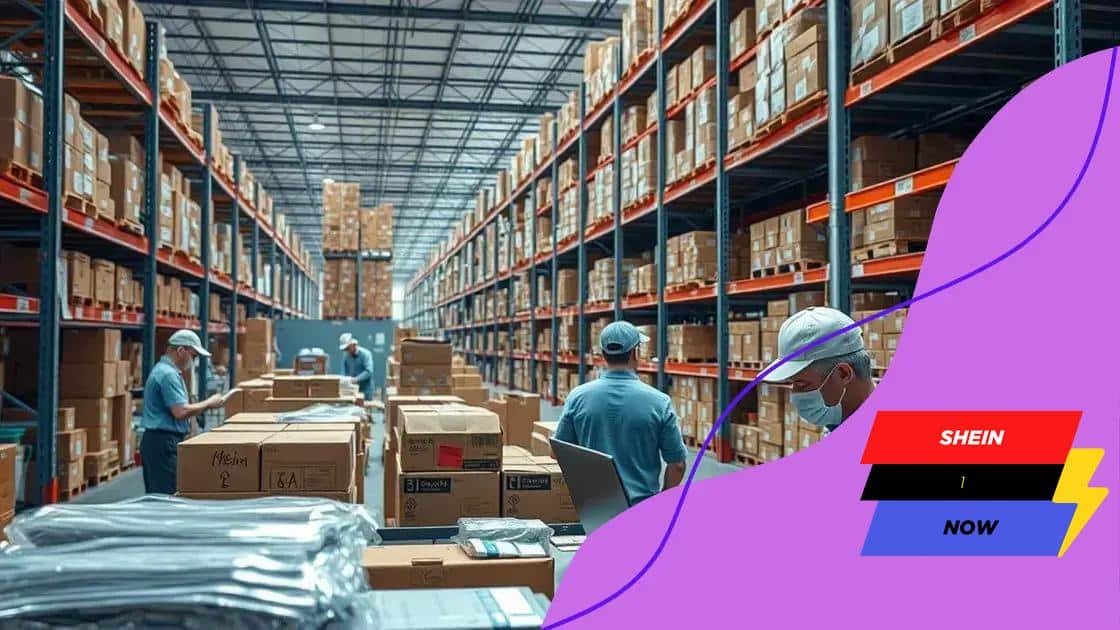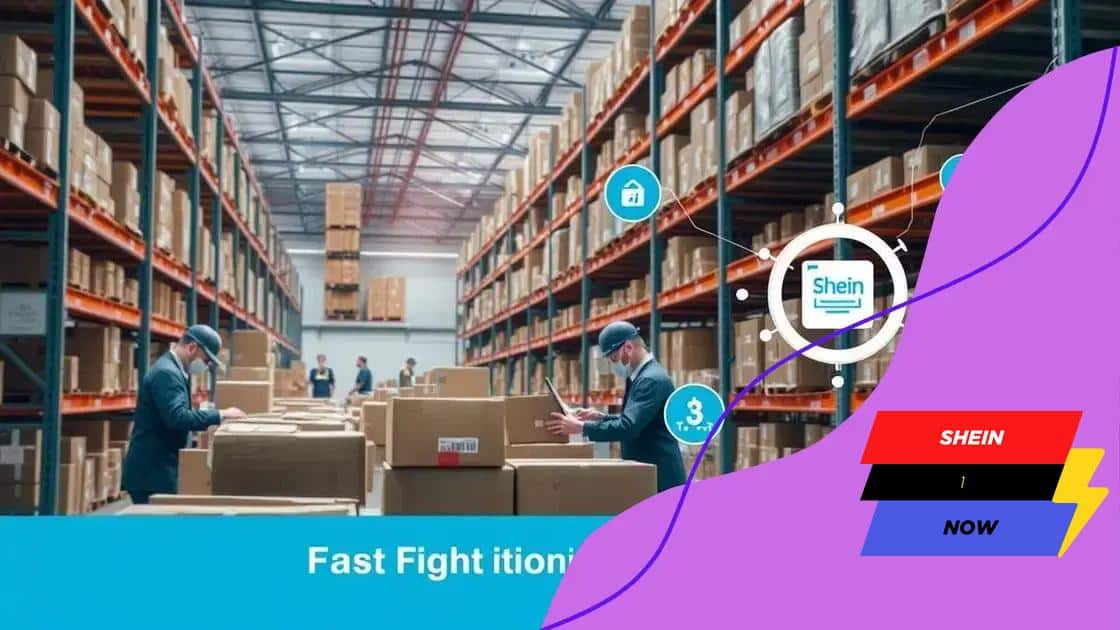How Shein manages logistics to reduce costs effectively

Shein manages logistics to reduce costs effectively by investing in automation, optimizing shipping routes, utilizing big data, and focusing on sustainability, thus maintaining competitive prices while ensuring fast delivery.
How Shein manages logistics to reduce costs is a critical aspect of its business model. By optimizing their shipping and warehouse systems, they create efficiencies that keep prices low for consumers. Curious about how they do it? Let’s dive into their strategies.
Understanding Shein’s supply chain strategy
Understanding Shein’s supply chain strategy is essential for grasping how they achieve cost savings while maintaining fast delivery. Their approach focuses on several key elements that enhance efficiency and responsiveness.
Key Elements of Shein’s Supply Chain
One of the primary components of Shein’s strategy is their ability to quickly respond to trends. They leverage data analytics and insights from customer behavior to guide their production processes. This method ensures that they are always a step ahead in the fashion game.
Benefits of a Responsive Supply Chain
A responsive supply chain has notable benefits:
- Reduced inventory costs by minimizing excess stock.
- Faster trend response, allowing them to adapt designs based on real-time customer feedback.
- Improved customer satisfaction through timely deliveries of in-demand styles.
Additionally, Shein maintains close relationships with their suppliers, ensuring that they can scale production up or down based on demand fluctuations. This agility is crucial in the fast-paced fashion industry. Another important factor is their use of technology. Automated processes in warehousing and distribution help them streamline operations, further decreasing costs.
Challenges Faced
However, navigating this complex supply chain is not without challenges. For instance, navigating logistics across different regions can lead to delays and increased costs if not managed properly. Shein addresses these challenges by continually refining their logistics strategies and investing in new technologies.
By understanding the intricacies of Shein’s supply chain strategy, businesses can gain insights into best practices for managing logistics and improving cost efficiencies. This dynamic approach not only enables them to thrive in a competitive market but also enhances their ability to meet customer expectations swiftly and effectively.
Key logistics technologies used by Shein
Key logistics technologies used by Shein play a critical role in their success and efficiency. These technologies help the company streamline operations, reduce costs, and speed up delivery times.
Warehouse Management Systems
One important technology is the Warehouse Management System (WMS). This system enhances inventory management by providing real-time data on stock levels. With accurate information, Shein can quickly respond to customer demands without overstocking.
Data Analytics
Data analytics is another crucial component. By analyzing purchase trends and customer preferences, Shein can predict which items are likely to sell well. This proactive approach helps them adjust their production and inventory accordingly.
- Real-time tracking allows for quicker decision-making.
- Forecasting models help in predicting demand accurately.
- Operational efficiencies lower overall logistics costs.
Additionally, Shein utilizes automated sorting processes in their distribution centers. Automation helps reduce errors and speeds up the packing and shipping of orders, ensuring customers receive their products faster. This focus on technology not only improves efficiency but also enhances customer satisfaction.
Furthermore, Shein employs advanced shipping technologies that optimize routes and delivery times. By collaborating with multiple courier services, they ensure timely deliveries at the lowest possible cost. This technology-driven approach keeps their supply chain agile and responsive to market changes.
Incorporating these technologies into logistics not only supports Shein’s growth but also sets them apart in a competitive industry. As they continue to evolve, the integration of new technologies will remain essential for maintaining their operational edge.
How Shein balances cost and speed

Shein has mastered the art of balancing cost and speed in its operations. By optimizing their supply chain, they can deliver trendy fashion items quickly without sacrificing affordability.
Efficient Production Processes
One way Shein achieves this balance is through efficient production processes. They utilize a fast-fashion model that allows them to quickly produce new designs based on the latest trends. This speed reduces the time from concept to consumer.
- On-demand production minimizes waste and keeps costs low.
- Frequent releases keep inventory fresh, attracting repeat customers.
- Global sourcing allows them access to the best materials at competitive prices.
Additionally, Shein leverages technology to enhance their logistics. Advanced data analytics predict which items will sell, allowing them to focus production on high-demand products. This proactive approach means that resources are utilized efficiently, further reducing costs.
Strategic Shipping Solutions
Another component of balancing cost and speed includes their strategic shipping solutions. By working with multiple carriers, Shein can choose the most efficient shipping methods for various destinations. This flexibility helps to minimize shipping costs while ensuring that orders arrive on time.
Moreover, Shein has increased its investment in warehousing and distribution centers. These centers are strategically placed to optimize delivery routes. With warehouses closer to major markets, they can reduce delivery times significantly.
The blend of maintaining low production costs while ensuring speedy delivery allows Shein to compete effectively in the fashion market. Their ability to adapt and innovate continuously helps them stay ahead of trends, which is key to their ongoing success.
Impact of logistics on Shein’s pricing model
The impact of logistics on Shein’s pricing model is a crucial element in their overall business strategy. By optimizing their logistics operations, Shein can keep prices competitive while ensuring timely delivery of products.
Cost Reduction through Efficient Logistics
One significant way logistics affects pricing is through cost reduction. Smart logistics solutions allow Shein to lower expenses associated with production, warehousing, and shipping. This reduction in costs is vital as it enables the company to pass savings on to customers.
- Streamlined shipping practices help lower transportation fees.
- Improved inventory management reduces holding costs.
- Negotiated rates with couriers lower shipping expenses.
Additionally, Shein’s strategy of keeping inventory close to key markets decreases shipping times and costs. This efficiency allows them to offer faster shipping options without increasing prices significantly. A well-managed supply chain means they can avoid delays that might lead to customer dissatisfaction.
Dynamic Pricing Adjustments
Logistics also plays a role in dynamic pricing adjustments. Shein monitors market trends and logistical factors to adjust prices based on demand and supply conditions. If a specific item trends upwards in popularity, the logistics team ensures that sufficient stock is available to meet demand, allowing the pricing to remain stable.
By maintaining an agile logistics network, Shein can react quickly to changes in consumer interest. This responsiveness is a key factor that allows them to keep prices attractive while meeting customer expectations efficiently.
The integration of logistics into Shein’s pricing strategy demonstrates the importance of operational efficiency in modern retail. By continuously analyzing their logistics processes, Shein can refine their pricing model and enhance their market position.
Future trends in Shein’s logistics management
Future trends in Shein’s logistics management will likely focus on greater efficiency and sustainability. As the fashion industry evolves, so must the strategies that companies like Shein employ to stay competitive while meeting consumer expectations.
Investment in Automation
One of the most significant trends is the continued investment in automation. Automated systems for inventory management and order fulfillment are becoming essential. These technologies help reduce errors and improve processing times, allowing Shein to scale operations quickly.
- Robotic process automation can streamline warehouse operations.
- AI-driven decision-making improves efficiency in supply chain management.
- Automated sorting systems speed up the packing and shipping process.
By integrating such technologies, Shein is positioning itself to handle increasing order volumes without a corresponding increase in labor costs.
Sustainability Initiatives
Another trend is the emphasis on sustainability. Consumers are becoming more conscious of their environmental impact, and Shein is responding by making logistics more eco-friendly. This includes using sustainable packaging, optimizing delivery routes, and exploring renewable energy sources for their operations.
Furthermore, Shein may work towards refining their supply chain to focus on local sourcing, thus decreasing the carbon footprint associated with long-distance shipping. These initiatives not only enhance their brand image but also align with evolving consumer values.
Data-Driven Strategies
Additionally, leveraging big data for logistics management will be crucial in the future. By analyzing trends and consumer behavior, Shein can optimize their inventory and improve delivery times. This data-driven approach allows for better forecasting and resource allocation, ensuring they meet customer demands effectively.
With these trends, Shein aims to create a logistics network that is not only efficient and fast but also responsible. The logistics of the future will play a crucial role in shaping how effectively Shein can cater to its global customer base, ensuring they remain a leader in the fashion industry.
FAQ – Frequently Asked Questions about Shein’s Logistics Management
How does Shein use automation in its logistics?
Shein invests in advanced automation systems to streamline its warehouse operations, improving efficiency and reducing errors in order fulfillment.
What role does sustainability play in Shein’s logistics?
Sustainability is important to Shein as they focus on eco-friendly practices, such as using sustainable packaging and optimizing delivery routes to lower their carbon footprint.
How does Shein leverage data in logistics management?
Shein utilizes big data analytics to predict trends, manage inventory effectively, and make informed decisions to improve their logistics operations.
Why is quick delivery important for Shein?
Quick delivery enhances customer satisfaction and loyalty, allowing Shein to meet consumer demands in the fast-paced fashion industry.





